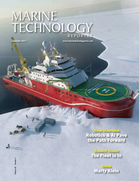Smarter Ocean Robotics
By Kira Coley
It is evident by now that we are in a robotics revolution. In almost every industry, from healthcare to hospitality, robots are emerging that can successfully complete a task without the human element. Artificial intelligence (AI) is also advancing at phenomenal rates beyond what some imagined possible this decade. The marine sectors have embraced robotics in data collection and exploration, but the infancy of AI in our industry delays progress toward the perfect synergy between humans and machines in the underwater realm.
The problem is, for robots exploring complex ocean environments, ‘smart thinking’ is easier said than done, according to Dylan Jones, a PhD researcher at Oregon State University. Jones talks about his efforts in progressing AI for underwater robotics, and the new algorithms that could lead to smarter vessels and more energy efficient missions.
“At the moment operators tell the vehicle to go from point A to B for example, and the robot will go there in a straight line. Today’s ocean robots aren’t doing anything clever in that sense, and there is still a significant workload for the human to deal with. What we are hoping to do is to make these missions easier so the human can focus on other things,” Jones said.
“My research explores how robots can decide the best path to take during a mission without the human. But, as is often the case, the ocean adds another layer of difficulty to this problem. So, more specifically we are exploring how vehicles can make decisions in these complex environments that allow them to perform their missions more efficiently.”
Jones and PhD advisor Geoff Hollinger, assistant professor of mechanical engineering in OSU’s College of Engineering, have built a framework for underwater vehicles to choose the most energy-efficient routes by considering environmental disturbances, such as ocean currents and surface winds.
Ocean currents can have a massive influence on the efficiency of vehicles and, therefore, the length of time they can stay out in the field. When the algorithms are integrated into vehicles such as AUVs and gliders, they should have the ability to think intelligently, ‘what is the most efficient way to get from point A to point B in this environment?’ If they can learn to do that, then these vehicles could expand the life of the mission by days, weeks, or perhaps even months.
Smarter Thinking
The framework designed as part of the university’s robotic program involves an algorithm that samples alternate paths, as well as comparison metrics that lets a vehicle decide when it makes sense to switch paths based on new information collected about the environment.
“We use forecast data to plan missions, but that means in truth we are just estimating. So, the re-planning element of this research is accounting for that. The robots can determine when the forecast is wrong and adjust their path. For example, based on the forecast data it expects the current to be going south but it is going south east, so the robot can learn as it executes and adapts its plan accordingly. It’s similar to what humans do when avoiding traffic on roads – we learn about our environment, and then we adapt,” Jones said.
The results, recently published in IEEE Robotics and Automation Letters, show that the algorithm can plan vehicle paths that are more energy efficient than ones planned by existing methods. It’s also robust enough to deal with environments for which not much data is available.
Jones’s research will also deal with “informative path planning” – planning paths that initially gather information about the environment and disturbances that the algorithm can use later to plan more energy-efficient routes.
“What we want to do is to put these two things together. So, how can we collect the data oceanographers want but still travel efficiently? Is there a way to balance these things to prioritize tasks? And, are there benefits if the robot is less optimal at the start? Let’s say you are driving from point A to B. Rather than going straight to point B you decide to check the traffic on the freeway by driving over the overpass. If it is clear, you get on the freeway but if there is traffic you take a different route. So, when it comes to robots, you might start by taking a slightly less optimal route to find out more about the environment. Using that information, you can then plan the most optimal journey for your mission.”
But how can engineers combine these two ideas – planning a path for energy efficiency while also trying to gather information that will inform efficient path planning? Jones explained, “There will be trade-offs, that might include decisions such as sacrificing five hours early in the mission to save six hours later. Another possible direction is to look at cooperation between multiple vehicles. In this scenario, one vehicle ‘wastes’ energy by scouting ahead and relays information so the other vehicle(s) can take the most efficient path – working as a unit, this could mean a low shared energy cost by intelligently assigning goals and sharing information. But one of the hard parts about robotics research is getting this entire system to work together. It is often just as hard as building the initial algorithm in the first place.”
Progressing AI in the Ocean Environment
Over the next decade advancements in this field will progress the industry closer towards the perfect synergy between humans and machines. The way we control underwater vehicles at present is relatively limited, leaving a lot of potential over the next few years for more autonomy to be built in. Jones added, “I think there will always be a human element in ocean robotics. Maybe the oceanographer will see something they find fascinating during a mission, and want to change the parameters to explore it further. That is a very hard question for us to solve algorithmically. It involves figuring out what the trade-offs are and how much do we care about one data set versus another.”
In the ideal world, the technology should be in place that allows the human to focus on high-level tasks – such as considering how the data is useful and what other data the robots should be collecting. The robot, however, should manage the lower level calculations – for example, how does it best and most efficiently collect the data that the human wants.
Jones said, “Humans have an intuition about what is efficient – we know we don’t want to go against the current – but they would struggle to do the calculations while traveling across the path. This is where the potential of robotics really shines. As engineers, we need to start thinking about how we can tease those tasks apart so the human can do what they’re good at and the robots can do what they’re good at. This is something else that our lab works on and it is ultimately what the industry should strive towards - the idea of shared autonomy. We need to learn how robots and humans best work together in the ocean environment so we can design solutions that allow us to collaborate in a way that strengthens both capabilities.”
Acknowledgements
Dylan Jones, Oregon State University


 August 2025
August 2025



